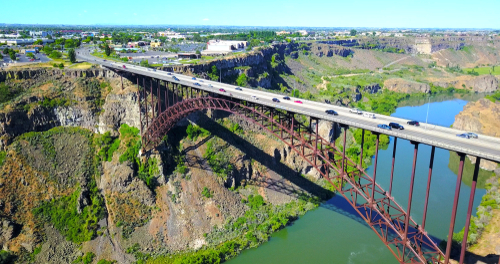
Idaho needs a total of $241.8 million in annual revenue to fund the modernization of its transportation infrastructure, which must be revitalized to meet unprecedented growth across the state, according to a new report released jointly by Boise State University and the Indiana Policy Institute.
“Ultimately, without adequate investment in its transportation system, Idaho’s economy and its people will be negatively impacted,” conclude experts in the report, Idaho’s Transportation Infrastructure: Moving Idaho Forward 2020, which utilizes data from both the Idaho Transportation Department and the Local Highway Technical Assistance Council.
That’s because Idaho faces a unique challenge being a relatively large state with a small population.
In fact, when compared to other states, Idaho has more land area with transportation infrastructure having fewer residents and revenue sources to fund infrastructure projects, according to the report, which notes that the state has 15.5 residents per lane mile, while the typical state has 40 residents per lane mile.
Another unique funding challenge stems from Idaho’s area of non-taxable public lands. Roughly two-thirds of Idaho’s land is owned by the federal and state government, ranking it one of the highest public land percentages among states, the report says.
At the same time, Idaho’s population is growing and has increased 14 percent during 2010-2019, while there was a 31-percent increase in registered vehicles from 2010 to 2018, according to state data.
Yet the annual revenue enhancement of $131 million since 2015 has not kept the same pace and revenue instability continues to hinder Idaho’s ability to maintain its transportation system in a state of good repair and prevent any major expansions or operational changes, including for roads, bridges, public transportation, and bicycle and pedestrian infrastructure, according to the report.
Going forward, the report’s experts point out that of the $241.8 million total Idaho needs each year in additional revenue to fund the update of its transportation infrastructure, $236.5 million per year would meet preservation and restoration goals of the state and local systems, while at least $5.3 million per year is needed to maintain existing transit equipment and infrastructure.
If funding is not available and maintenance is deferred for the preservation and restoration goals, then the annual figure would compound, making the funding requirement significantly larger in the future, the report’s experts say.
Similarly, the $5.3 million needed per year to maintain existing transit equipment and infrastructure does not include equipment replacement or unfunded expansions and related operations for all infrastructure, including for roads, bridges, bikes, pedestrians, and transit, added the experts.
For instance, 239 of Idaho’s 3,761 bridges measuring greater than 20 feet in span are in poor condition, while the annual cost per motorist driving on Idaho infrastructure in need of repair exceeds $420 annually, according to the report.
To determine how Idaho must modernize the way it funds such maintenance and the operations of its transportation system while also providing safety and capacity enhancements, the report’s experts examined the state’s current funding mechanisms and considered some new alternatives.
For example, regarding the state’s current user fees, Idaho might consider increasing both the fuel tax and registration fees, and the state could implement new user fees, such as a road usage charge and tolling, the experts wrote in the report.
In some cases, efficiencies also could be gained through reprioritizing maintenance and restoration and facilitating transit-oriented development, wrote the experts, who added that additional funding still would be necessary to meet the state’s transportation needs.
“Idaho must identify the most effective, safe, and efficient ways to address transportation needs of its growing population. It must also provide the infrastructure essential to a healthy economy that attracts and retains businesses,” according to the report. “This will require maintenance of the current transportation system and identifying and securing the technology, operations, regulations, funding, financing, and energy required to modernize it.”
By engaging Idaho residents and key transportation stakeholders, the state can move toward determining the alternative revenue and financing sources best equipped to both support its transportation infrastructure and modernize it, say the report’s experts, who called such an effort critical for the state’s competitiveness.
A group of transportation stakeholders contracted with the Idaho Policy Institute to reexamine Idaho’s transportation infrastructure for this report following changes over the last decade since a task force appointed by former Idaho Gov. Clement Leroy “Butch” Otter released the 2011 report, Modernizing Transportation Funding in Idaho. The group includes: the Ada County Highway District, the American Council of Engineering Companies of Idaho, the Association of Idaho Cities, the Community Planning Association of Southwest Idaho, Idaho Associated General Contractors, the Idaho Association of Counties, the Idaho Association of Highway Districts, the Idaho Forest Group, Idaho Trucking, Simplot Transportation, and Valley Regional Transit.